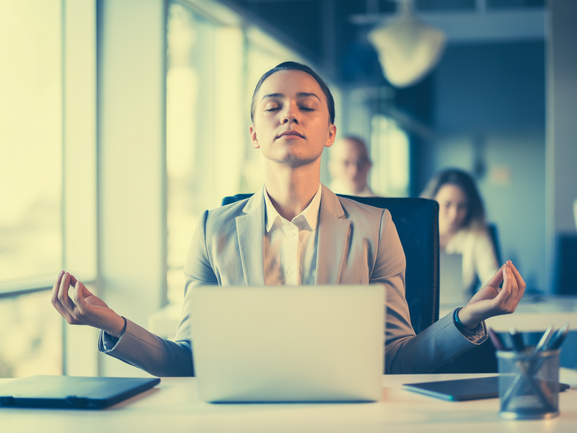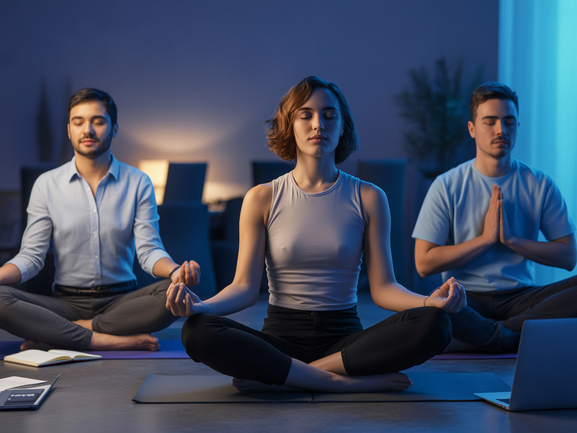Desk Meditation: Your Guide to a Calmer, More Focused Workday
What Is Desk Meditation and Why Do You Need It?
Desk meditation is the practice of simple mindfulness techniques performed at your workspace. These accessible exercises are designed to reduce stress, improve focus, and alleviate physical discomfort—all without leaving your chair. In a world where the average professional spends over 90,000 hours at work in their lifetime, integrating well-being into our professional lives is no longer a luxury; it’s a necessity. At Vitalizen.app | Yoga e meditação, we champion this seamless integration.
The modern workday is a minefield of stressors: constant digital notifications, back-to-back meetings, and the physical strain of a sedentary role. You might recognize the symptoms: persistent back pain, shoulder tension, or a constant feeling of being overwhelmed. These are not just signs of a tough day; they are signals from your body and mind calling for a reset. Mindfulness for office workers provides a powerful, immediate solution by embedding moments of calm and awareness directly into your daily routine.

The Science-Backed Benefits of Mindfulness for Desk Workers
The advantages of integrating mindfulness into your workday are not just anecdotal. They are supported by a growing body of scientific research, proving that these practices are transformative for professionals who spend hours at a desk. The return on a small investment of time is immense.
“The findings indicate that mindfulness is crucial in influencing employees’ turnover intentions and well-being through perceived stress levels.” – 2024 Study on Workplace Mindfulness
1. Drastically Reduces Stress and Anxiety
Chronic workplace stress can wreak havoc on your nervous system. Regular desk meditation practice is proven to lower cortisol, the body’s primary stress hormone. By taking short, seated meditation breaks, you activate the parasympathetic nervous system, shifting your body from a state of “fight or flight” to “rest and digest.” This practice helps you manage stress, improve emotional regulation, and foster a more resilient mindset amidst workplace challenges.
2. Alleviates Chronic Physical Discomfort
Prolonged sitting is a leading cause of chronic back pain, poor posture, and repetitive strain injuries. Techniques like the body scan increase your proprioception—your awareness of your body’s position in space. This heightened awareness prompts you to make corrective postural adjustments throughout the day. Furthermore, mindful breathing helps release deep-seated tension in the shoulders, neck, and jaw.
3. Supercharges Focus and Productivity
In an economy of distraction, focus is a superpower. Mindfulness is essentially attention training. Each time you guide your wandering mind back to a focal point, like your breath, you are strengthening your prefrontal cortex. This mental workout enhances your ability to concentrate for longer periods, reduces mental fatigue, and boosts the overall quality and efficiency of your work. Ready to begin? Comece agora sua jornada de bem estar.
4. Enhances Emotional Intelligence and Relationships
Workplace dynamics can be complex. Desk meditation practices, particularly Loving-Kindness Meditation, cultivate empathy and compassion. By developing a less reactive and more observant mindset, you can improve communication with colleagues, navigate conflicts more effectively, and contribute to a more positive and collaborative work environment.
How to Start Your Desk Meditation Practice Today: 5 Simple Techniques
You don’t need a silent retreat or a special cushion to begin. Your office chair is the perfect launchpad for your meditation journey. Here are five powerful seated meditation techniques you can try right now for a mental and physical reset.
1. The Five-Minute Mindful Breathing
This is the cornerstone of mindfulness. Sit comfortably with your feet flat on the floor and your back straight but not rigid. Gently close your eyes or lower your gaze. Turn your attention to the natural rhythm of your breath. Notice the sensation of the cool air entering your nostrils and the warm air exiting. Your mind will wander—that is its nature. When it does, simply acknowledge the thought without judgment and gently guide your focus back to your breath. Five minutes is all it takes to feel a significant shift.
2. The Ten-Minute Body Scan Meditation
This technique is exceptionally effective for releasing stored physical tension. In a comfortable seated position, bring your awareness to the soles of your feet. Notice any sensations—warmth, pressure, tingling—without needing to change them. Slowly, guide your attention up through your ankles, calves, knees, and thighs. Continue this scan through your torso, arms, neck, and face, and finally to the crown of your head. As you scan each body part, consciously invite any tightness you discover to soften and release.
3. The Mindful Listening Practice
Instead of focusing inward, direct your attention outward to the soundscape of your office. Close your eyes and just listen. Notice the hum of your computer, the distant sound of traffic, the clicking of keyboards, the chatter of colleagues. Acknowledge each sound as it arises and passes without labeling it as “good” or “bad,” “pleasant” or “unpleasant.” This practice anchors you firmly in the present moment, using your environment as a tool for mindfulness.
4. The Loving-Kindness Meditation for Work
This practice helps cultivate compassion for yourself and others, transforming your work relationships. Silently repeat phrases directed at yourself, such as, “May I be happy. May I be healthy. May I be safe. May I work with ease.” After a few moments, extend these well-wishes to your colleagues, your manager, and even individuals you find challenging. This can profoundly improve your sense of connection and foster a more positive team dynamic.
5. The Mini-Vacation Visualization
Use your imagination as a powerful tool for a mental reset. Close your eyes and transport yourself to a place of peace and tranquility. This could be a sun-drenched beach, a quiet forest, or a majestic mountaintop. Engage all your senses: What do you see? What sounds do you hear? What do you smell? Feel the sun on your skin or the cool breeze. Spending just a few minutes in this mental sanctuary can help you return to your tasks feeling refreshed and renewed.
Breathing Exercises for Instant Calm at Your Desk
Your breath is a powerful, portable tool for regulating your nervous system. Here are three exercises you can do at your desk for immediate stress relief.
The 4-7-8 Breath
Developed by Dr. Andrew Weil, this technique is a natural tranquilizer for the nervous system. Inhale quietly through your nose for a count of four, hold your breath for a count of seven, and then exhale completely and audibly through your mouth for a count of eight. Repeat this cycle 3-4 times to feel a wave of calm. For more tips, visit our blog: Artigos, notíticas, dicas e orientações de yoga e meditação.
Box Breathing (Square Breathing)
This simple and effective technique is used by Navy SEALs to maintain focus under pressure. The balanced pattern is easy to remember:
- Inhale through your nose for a count of four.
- Hold your breath for a count of four.
- Exhale through your mouth for a count of four.
- Hold your breath for a count of four.
Diaphragmatic (Belly) Breathing
Many of us breathe shallowly from our chest. This exercise promotes deep, relaxing breaths. Place one hand on your chest and the other on your belly. Inhale slowly through your nose, focusing on expanding your belly outward (the hand on your belly should rise). Your chest should remain relatively still. Exhale slowly, allowing your belly to fall. This type of breathing maximizes oxygen exchange and signals relaxation to your brain.
Overcoming Common Obstacles to Desk Meditation
Starting a new habit can be challenging, especially in a busy office. Here’s how to navigate common hurdles:
- “I’m too busy to meditate.”: Start with just two minutes. The goal is consistency, not duration. Use transition moments, like waiting for a file to download or before a meeting starts. The ROI in focus will likely save you more time than you invest.
- “My office is too noisy.”: Use the noise as your meditation object with the Mindful Listening technique. Alternatively, invest in a pair of noise-canceling headphones and listen to a guided meditation on an app like Vitalizen.
- “I feel self-conscious or silly.”: Most desk meditation techniques are invisible to others. Mindful breathing or a body scan can be done with your eyes open, looking at your screen. No one will know you’re meditating.
- “I can’t quiet my mind.”: This is the most common misconception. The goal is not an empty mind. It’s to notice when your mind has wandered and gently bring it back. Every time you do this, you are successfully meditating.
Frequently Asked Questions About Desk Meditation
How much does desk meditation cost?
Desk meditation is completely free. All the techniques, from mindful breathing to body scans, require no special equipment or investment. The only resource you need is a few minutes of your time, making it one of the most accessible wellness practices available.
I’m too busy to meditate. How can I find the time?
Even five minutes can make a huge difference. Start small by scheduling a recurring five-minute break in your calendar. The goal is consistency, not duration. You can practice mindful breathing while waiting for a document to load or do a quick body scan before a meeting. To learn more about us, check out O que é Vitalizen.app?
What if I can’t quiet my mind?
This is the most common misconception about meditation. The goal is not to force an empty mind, but to simply notice when your mind has wandered and gently guide it back to your point of focus (like your breath). Think of it as a workout for your brain; each time you bring your focus back, you strengthen your attention muscle.
Can I really meditate at my desk with so much noise?
Absolutely. The Mindful Listening technique is specifically designed for noisy environments, as it uses the surrounding sounds as the focus of your meditation. Alternatively, you can use noise-canceling headphones to listen to a guided meditation from an app like Vitalizen. For more information, feel free to Contato us.
💡 Tip: These desk meditation and mindfulness tips are just the beginning. To truly unlock the transformative power of these practices, consider trying guided sessions on the Vitalizen App.
🎯 Ready to start? Don’t let stress dictate your workday. Take control of your well-being, one breath at a time. Start your free trial of Vitalizen today and discover the benefits of guided desk meditation!


